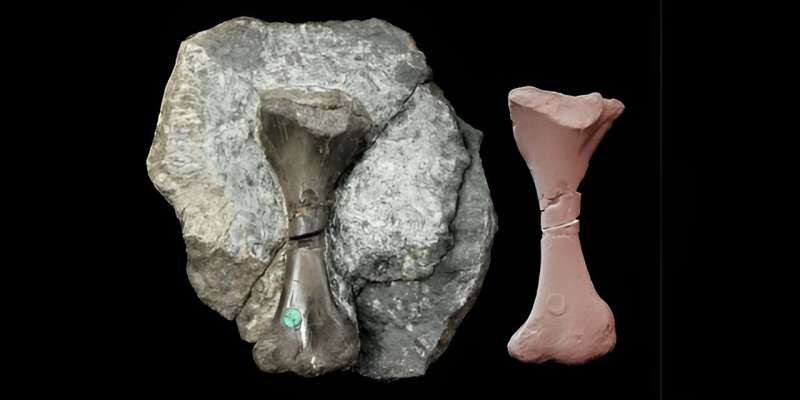This article has been reviewed according to Science X's editorial process and policies. Editors have highlighted the following attributes while ensuring the content's credibility:
fact-checked
peer-reviewed publication
trusted source
proofread
Shedding light on Scotland's first 'almost-mammal,' Saurodesmus robertsoni

Discovered in the early 1840s, Saurodesmus robertsoni is an enigmatic fossil that has puzzled scientists for over two centuries. A recent study by Dr. Tomasz Szczygielski and his team of international researchers has finally shed light on this elusive specimen, identifying it as the oldest known non-mammaliaform cynodont from Scotland and one of the earliest members of the tritylodontids. This discovery is exciting because it provides crucial insights into early mammal evolution and fills a significant gap in the fossil record.
The work is published in the journal PLOS ONE.
Saurodesmus robertsoni's story begins in the Late Triassic epoch, approximately 200 million years ago, in Linksfield, Scotland. The fossil, a damaged thigh bone (femur), was unearthed from ancient estuarine shales. Initially, the specimen's identity was a matter of considerable debate.
Over the years, it was misclassified as a turtle, a lizard relative and even a crocodilian. However, none of these labels stuck, and the fossil eventually faded into obscurity.
Dr. Szczygielski and his team of international researchers, including Dr. Marc Johan Van den Brandt (Wits University, South Africa), Dr. Leandro Gaetano (Instituto de Estudios Andinos, Argentina) and Dr. Dawid Dr.óżdż (Institute of Biocybernetics and Biomedical Engineering, Polish Academy of Sciences, Poland), recently re-examined the mysterious fossil.
"Despite extensive research, our understanding of early turtles remains incomplete. Since the specimen was historically considered a turtle, I decided it was worth revisiting," Szczygielski explains. The specimen turned out to be quite different from turtles, presenting an intriguing puzzle.
Using modern techniques and new comparative materials, Szczygielski and his team solved the puzzle of Saurodesmus robertsoni. They determined it was not a turtle, crocodile, or any other reptile but a derived cynodont, an ancient mammal relative.
"Rejecting the turtle and crocodilian identities was easy, but pinpointing its place in the tetrapod family tree was challenging. Dr. Dawid Dr.óżdż first suggested it might be a cynodont bone, a thrilling idea we validated through extensive comparisons," says Szczygielski.
Saurodesmus robertsoni's thigh-bone is fascinating due to its unique features. The bone has characteristics suggesting a more mammalian hip and hindlimb position than most other cynodonts. "These features suggest it was well-adapted for movement, hinting at an agile lifestyle," explains Szczygielski.
The reclassification of Saurodesmus robertsoni is a crucial piece in mammalian evolution. It represents the oldest cynodont from Scotland and one of the earliest tritylodontids worldwide, shedding light on the group's when and where this group lived.
Tritylodontids are closely related to the ancestors of mammals. Understanding their diversity and adaptations helps paleontologists trace the evolutionary steps that led to the emergence of mammals, including humans.
This research highlights the importance of revisiting historical specimens in paleontology. Fossils collected in the 19th and early 20th centuries were often interpreted with limited knowledge and technology. Modern techniques, such as advanced imaging and comparative anatomy, can reveal new insights and lead to significant taxonomic revisions, as seen with Saurodesmus robertsoni.
Szczygielski explains, "3D imaging allows easier and more accurate work with specimens from various collections, even across continents. Unusual and incomplete bones can be better understood with 3D models than with drawings or photos." New anatomical features can be identified and examined from all angles, making the study of these fossils much more comprehensive.
"The revision of Saurodesmus robertsoni brought clarification of the distribution and expected range of limb bone anatomy of turtles in the Triassic, and I will be researching this topic further," Szczygielski explains.
More information: Tomasz Szczygielski et al, Saurodesmus robertsoni Seeley 1891—The oldest Scottish cynodont, PLOS ONE (2024). DOI: 10.1371/journal.pone.0303973
Journal information: PLoS ONE
Provided by Wits University





















